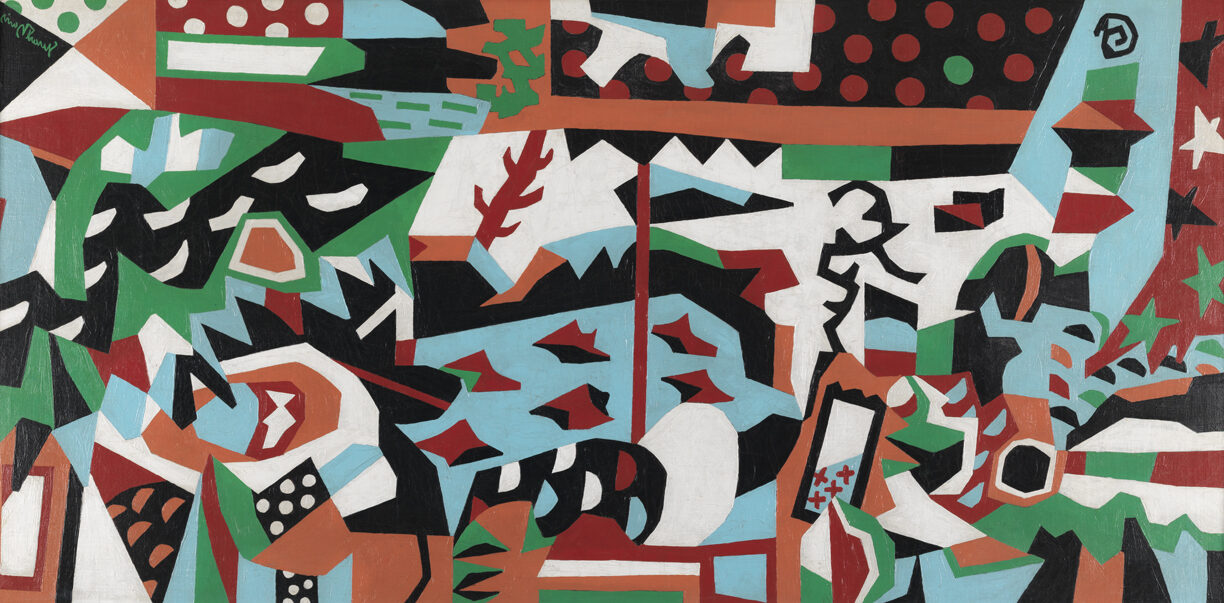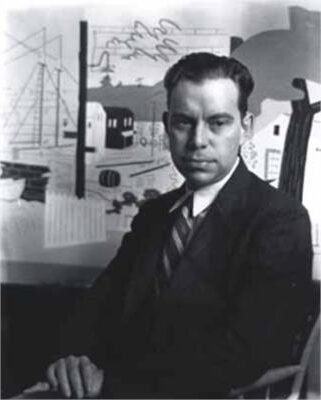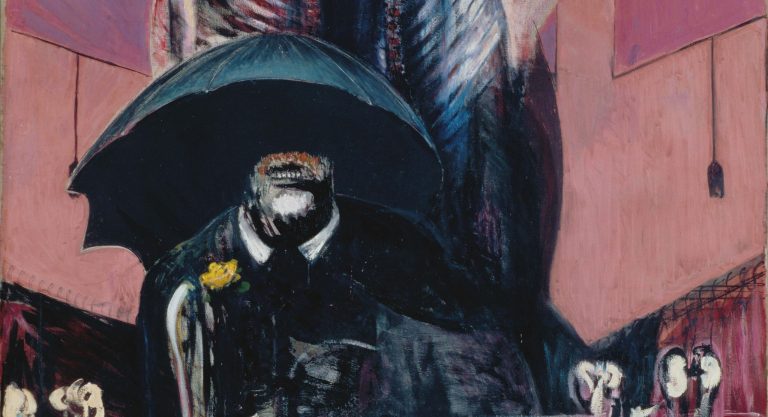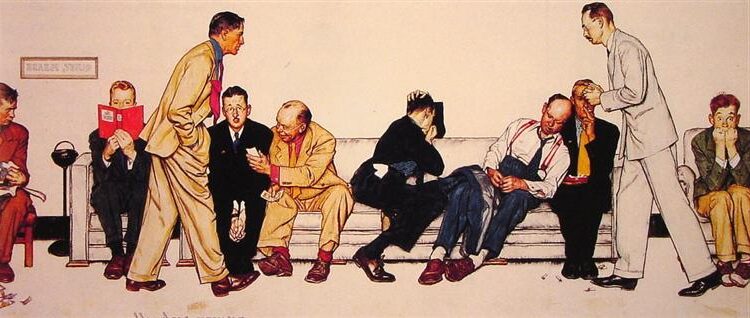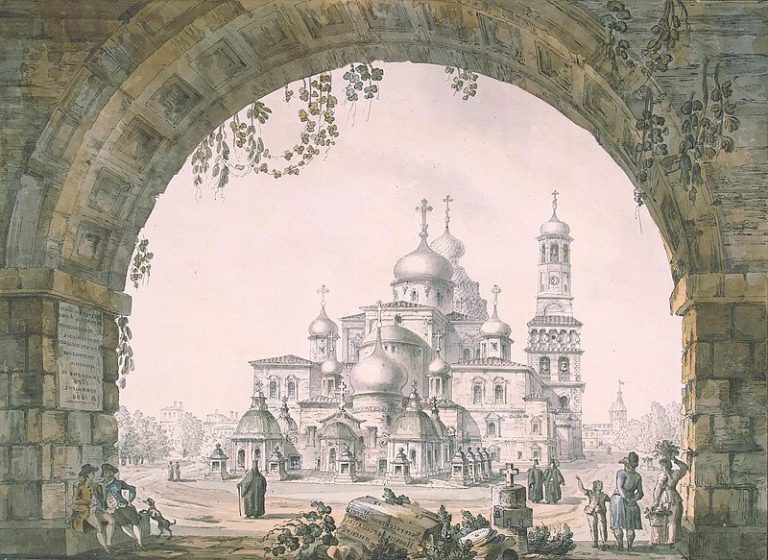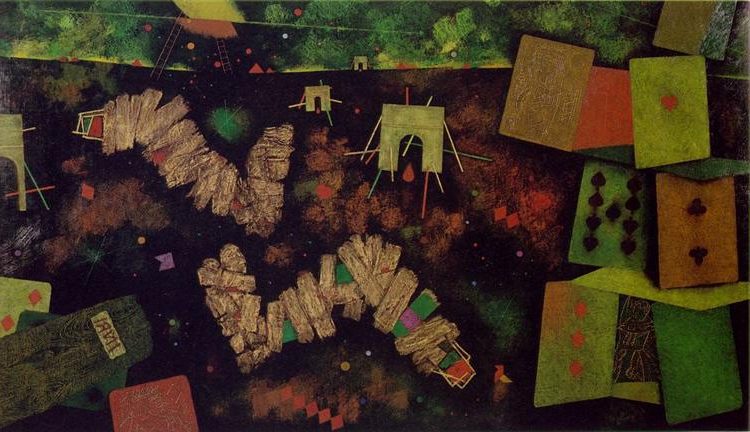Stuart Davis Painter: Revolutionary American Modernist and His Iconic Works
Born: December 7, 1892, Philadelphia, Pennsylvania, US
Death: June 24, 1964, New York City, US
Art Movement: American Modernism
Nationalité : Américain
Teacher: Robert Henri
Institution: Robert Henri School of Art, New York
Stuart Davis Painter: Revolutionary American Modernist and His Iconic Works
Premières années de vie et débuts artistiques
Stuart Davis was born on December 7, 1892, to artistic parents in Philadelphia. His upbringing in a creative household laid the foundation for his future as one of America’s most influential modern painters.
The Ashcan School Influence
Stuart Davis began his artistic journey with the Ashcan School, a movement known for its realistic portrayals of daily urban life. This early influence shaped his approach to art, giving him a foundation in observational techniques and social awareness.
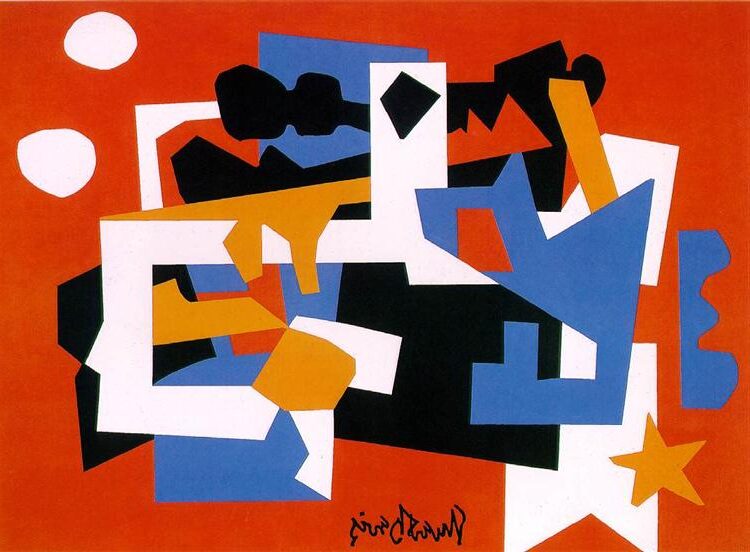
Colonial Cubism, 1954, by Stuart Davis
His mother, Helen Stuart Foulke, was a successful sculptor who regularly exhibited her work. His father was also an artist, providing Davis with a household that valued creative expression from his earliest years.
At just 16 years old, Davis took his first significant step into the art world. He began studying with Robert Henri, a leading figure in the Ashcan School. This mentorship introduced him to painting everyday scenes with honesty and directness.
Education at the Art Students League
Davis furthered his artistic education at the Art Students League, a prestigious institution that helped refine his skills and expose him to various artistic approaches. The League was known for its progressive teaching methods and diverse instructor roster.
During his time at the Art Students League, Davis developed technical abilities while being introduced to emerging modern art movements. This education broadened his perspective beyond the realism of the Ashcan School.
His training provided critical skills that would later support his experimentation with color, form, and abstraction. The Art Students League’s environment encouraged artistic exploration and individual expression.
These formative educational experiences prepared Davis to eventually develop his distinctive style, which would later blend elements of American urban life with European modernist techniques.
Evolution of Style and Major Works
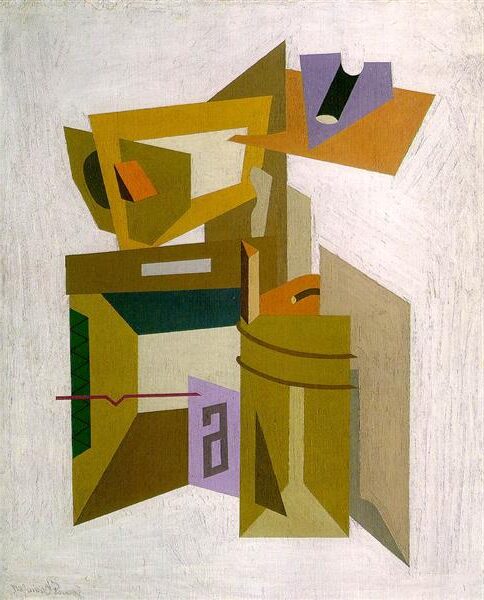
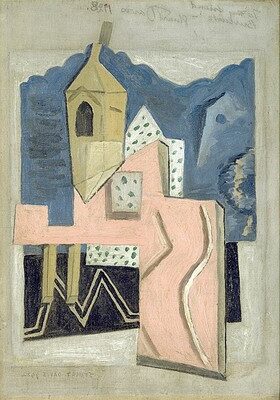
Stuart Davis’s artistic journey evolved dramatically throughout his career. His style developed from early realist works to vibrant abstract compositions that captured La vie américaine with bold colors and jazz-like rhythms.
Armory Show and European Influence
The 1913 Armory Show marked a turning point in Davis’s career. This exhibition introduced him to European modernism, particularly the works of Van Gogh, Matisse, and Picasso. Their bold use of color and form deeply impressed the young artist.
Davis began experimenting with different styles after this exposure. The vibrant colors of the Fauves and the structured approach of Cubism became evident in his work.
In 1928, Davis traveled to Paris, spending a year absorbing European art movements firsthand. This experience reinforced his appreciation for Cubism and helped him develop his unique visual language.
Davis incorporated these European influences while maintaining his distinctly American perspective, setting him apart from his contemporaries.
Development of Abstract Art
By the 1920s, Davis began developing his mature style. His paintings evolved from realistic depictions to bold abstractions of American consumer culture and urban landscapes.
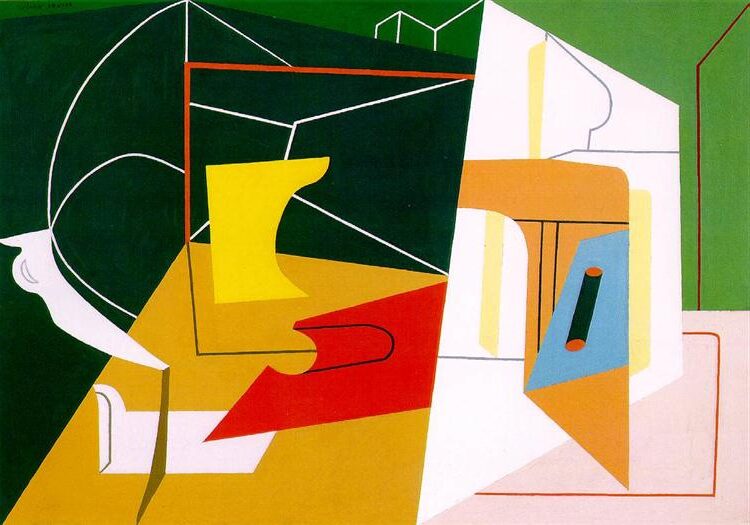
Egg Beater No. 4, 1928, by Stuart Davis
Davis created works like “Lucky Strike” (1921) and “Egg Beater” series (1927-28), showing his growing interest in abstraction. These paintings featured flattened perspective, bold outlines, and vibrant color schemes.
His style continued to evolve in the 1930s with works like “Swing Landscape” (1938), which showcased his jazz-inspired approach to composition with rhythmic patterns and bright colors.
Davis became known for incorporating everyday American objects and advertisements in his work. This approach predated Pop Art by decades and established him as a pioneer of American modernism.
Stuart Davis: In Full Swing
The exhibition “Stuart Davis: In Full Swing” at the Whitney Museum highlighted his most significant works from the 1920s until his death in 1964.
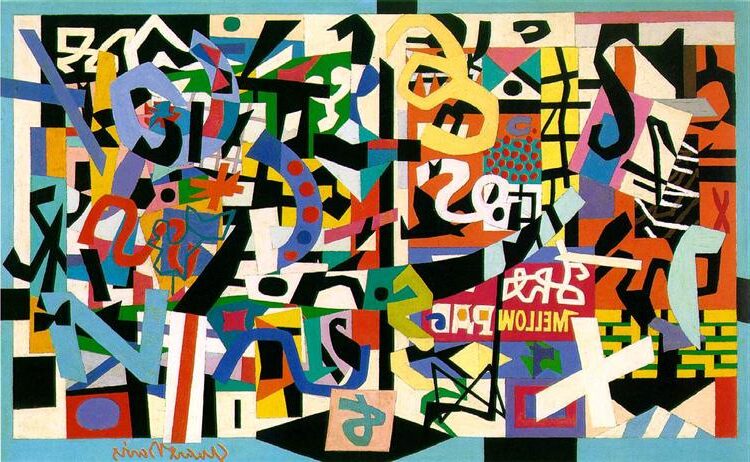
The Mellow Pad, 1951, by Stuart Davis
Davis’s later works featured more complex compositions with overlapping shapes, bold typography, and vibrant color contrasts. Paintings like “The Mellow Pad” (1945-51) and “Owh! In San Paõ” (1951) demonstrated his mature style.
His work during this period maintained a consistent visual language while growing increasingly sophisticated. Davis often revisited earlier themes, creating variations that showed his evolving perspective.
These later works solidified Davis’s reputation as one of America’s most important abstract artists. His unique combination of European modernist techniques with American subjects created a distinctive style that influenced generations of artists.
Inspiration, Themes, and Legacy
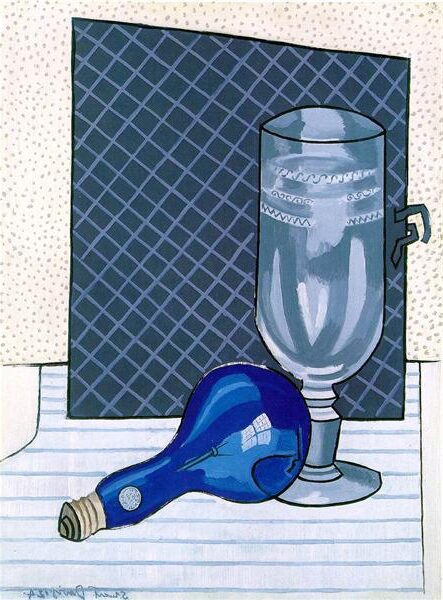

Stuart Davis drew from diverse sources to create his distinctive artistic voice. His work bridged European modernism with American themes, establishing him as a pivotal figure in the development of American art.
Music, Jazz, and Urban Influence
Davis found profound inspiration in jazz music, which shaped his visual rhythm and improvisational approach to composition. The syncopated beats of jazz translated into his vibrant color combinations and dynamic compositions. In New York and Greenwich Village, where Davis lived for many years, urban life provided endless material for his canvases.
Street scenes captured the energy of American cities with their commercial signs, storefronts, and bustling activity. Davis once remarked that his paintings attempted to capture the “color and rhythm of the American scene.”
His time in Gloucester, Massachusetts also influenced his work, where he painted harbor scenes with bold colors and patterns. These seaside compositions showed how Davis could transform ordinary American landscapes into rhythmic visual experiences.
Contribution to American Modernism
Davis stands as an American original who helped define American modernism in the early 20th century. Unlike many contemporaries who simply adopted European styles, Davis created a uniquely American visual language that celebrated commercial culture.
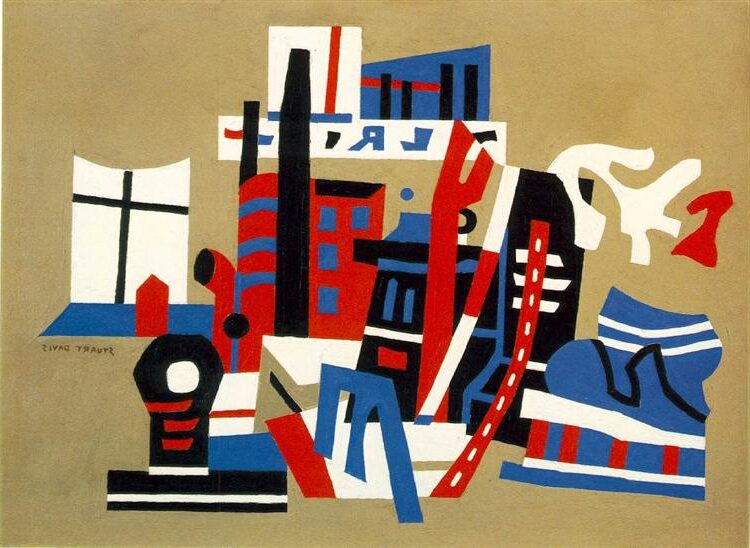
New York Waterfront, 1938, by Stuart Davis
His work during the Great Depression maintained optimism through color and rhythm when many artists turned to social realism. Davis taught at the New School for Social Research, influencing younger artists including Willem de Kooning.
Davis’s legacy extends to Pop Art, which built upon his integration of consumer imagery and advertising into fine art. His bold use of text, commercial imagery, and everyday objects anticipated themes that would become central to American art in the 1960s.
Though inspired by European modernists like Gauguin, Davis transformed these influences into something distinctly American, making him one of the most important painters of the 20th century.
Questions fréquemment posées
Stuart Davis created a significant body of work that spanned several decades and artistic movements. His distinctive style and contributions to American art continue to intrigue art enthusiasts and scholars alike.
What artistic movement is Stuart Davis associated with?
Stuart Davis is primarily associated with American Modernism and is considered one of America’s first modern artists. He began his career with the Ashcan School, studying under Robert Henri.
As his style evolved, Davis embraced European modernist movements, particularly Cubism. His work eventually incorporated elements of Abstract Expressionism.
Davis is also recognized as a forefather of Pop art, creating bold, graphic compositions decades before the movement officially began.
How did jazz influence Stuart Davis’s artwork?
Jazz music profoundly influenced Stuart Davis’s artistic style and approach. He translated jazz’s improvisational nature and rhythmic patterns into visual compositions.
Davis used bright, contrasting colors and overlapping shapes to create visual “syncopation” similar to jazz rhythms. His paintings often feature a sense of movement and energy that mirrors jazz music.
The titles of his works frequently referenced jazz, and he described his creative process as similar to jazz improvisation.
Can you describe the significance of ‘Swing Landscape’ in Stuart Davis’s body of work?
‘Swing Landscape’ (1938) represents one of Davis’s most ambitious and important works. The large mural-sized painting combines abstract forms with recognizable elements from the Gloucester, Massachusetts harbor.
The vibrant colors and rhythmic composition exemplify Davis’s translation of jazz music into visual art. The painting’s title directly references the swing jazz era popular at the time.
‘Swing Landscape’ demonstrates Davis’s unique American modernism—blending European cubist techniques with distinctly American subjects and cultural references.
What themes are commonly found in Stuart Davis’s paintings?
American identity and culture were central themes in Davis’s work. He proudly incorporated American subjects, from urban landscapes to consumer products.
Commercial imagery and text frequently appear in his paintings, reflecting his interest in advertising and popular culture. Davis often included words, letters, and symbols as compositional elements.
The rhythm and energy of modern life, particularly urban environments, inspired many of his compositions. His work celebrated the vibrancy of American cities and everyday objects.
How did Stuart Davis contribute to the development of American Modernism?
Davis helped define a distinctly American version of modernism by combining European avant-garde techniques with American subjects and themes. His work bridged European abstraction with American cultural references.
He demonstrated that modernist approaches could express American experiences without simply imitating European styles. Davis’s integration of commercial imagery and text influenced later Pop artists.
As an early adopter of abstraction in American art, Davis helped pave the way for Abstract Expressionism while maintaining his unique visual language.
What were some notable exhibitions or retrospectives that featured Stuart Davis’s work?
The Whitney Museum of American Art has hosted several major Stuart Davis retrospectives. These include comprehensive shows in 1991 and 2016. These exhibitions highlighted his evolution as an artist.
The Museum of Modern Art (MoMA) featured Davis’s work in important exhibitions of American modernism throughout his career and posthumously.
Davis participated in the groundbreaking 1913 Armory Show. This show introduced European modernism to American audiences. This early exposure to avant-garde art significantly influenced his subsequent artistic development.

